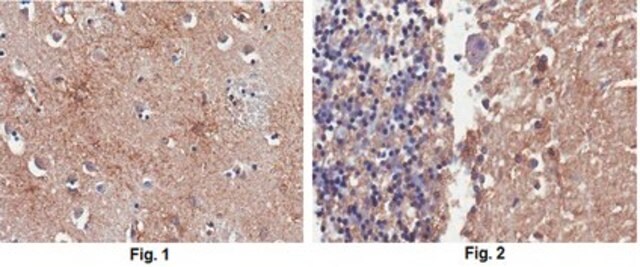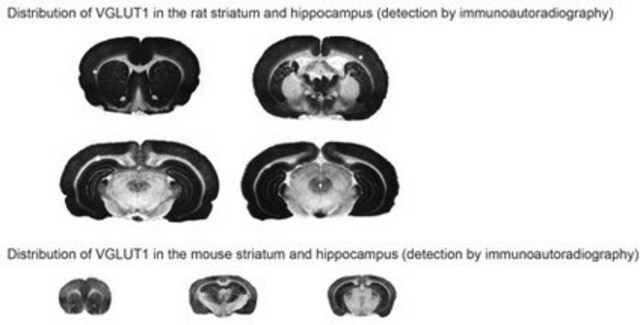574777
Anti-Synapsin I Rabbit pAb
lyophilized, Calbiochem®
Synonym(s):
Rabbit Anti-Synapsin I, Synapsin I Detection Antibody
Sign Into View Organizational & Contract Pricing
Select a Size
All Photos(1)
Select a Size
Change View
About This Item
UNSPSC Code:
12352203
NACRES:
NA.41
Recommended Products
biological source
rabbit
Quality Level
antibody form
affinity isolated antibody
antibody product type
primary antibodies
clone
polyclonal
form
lyophilized
does not contain
preservative
species reactivity
human, rat, mouse, bovine
manufacturer/tradename
Calbiochem®
storage condition
OK to freeze
General description
Immunoaffinity purified rabbit polyclonal antibody. Recognizes the synapsin I protein.
Recognizes the synapsin I protein in rat brain.
This Anti-Synapsin I Rabbit pAb is validated for use in ELISA, Immunoblotting Immunocytochemistry Immunoprecipitation for the detection of Synapsin I.
Immunogen
Bovine
purified, brovine brain synapsin I
Application
ELISA (1:2500-1:10,000)
Frozen Sections (see application references)
Immunoblotting (1:200)
Immunocytochemistry (1:500-1:2500)
Immunoprecipitation (1 µg/200 µg lysate)
Frozen Sections (see application references)
Immunoblotting (1:200)
Immunocytochemistry (1:500-1:2500)
Immunoprecipitation (1 µg/200 µg lysate)
Warning
Toxicity: Standard Handling (A)
Physical form
Lyophilized from 5 mM ammonium bicarbonate.
Reconstitution
Reconstitute with 50 µl PBS. Following reconstitution, aliquot and freeze (-20°C). Avoid freeze/thaw cycles of solutions.
Analysis Note
Positive Control
Rat brain
Rat brain
Other Notes
Stone, L.M., et al. 1994. J. Neurosci.14, 301.
Mandell, J.W., et al. 1992. J. Neurosci.12, 1736.
Fletcher, T.L., et al. 1991. J. Neurosci.11, 1617.
Moore, R.Y., and Berstein, M. 1989. J. Neurosci.9, 2151.
Mandell, J.W., et al. 1992. J. Neurosci.12, 1736.
Fletcher, T.L., et al. 1991. J. Neurosci.11, 1617.
Moore, R.Y., and Berstein, M. 1989. J. Neurosci.9, 2151.
This antibody is specific for synapsin I and can be used to estimate synaptic density and synaptogenesis. Strong and specific immunolabeling of the synapsin I doublet seen in immunoblotting at a 1:200 dilution. This immunolabeling can be blocked by preadsorption of antibody with synapsin I. Variables associated with assay conditions will dictate the proper working dilution.
Legal Information
CALBIOCHEM is a registered trademark of Merck KGaA, Darmstadt, Germany
Not finding the right product?
Try our Product Selector Tool.
Storage Class
11 - Combustible Solids
wgk_germany
WGK 1
Certificates of Analysis (COA)
Search for Certificates of Analysis (COA) by entering the products Lot/Batch Number. Lot and Batch Numbers can be found on a product’s label following the words ‘Lot’ or ‘Batch’.
Already Own This Product?
Find documentation for the products that you have recently purchased in the Document Library.
Bao-Yang Hu et al.
Methods in molecular biology (Clifton, N.J.), 636, 123-137 (2010-03-26)
We describe a chemically defined protocol for efficient differentiation of human embryonic stem cells (hESCs) to neural epithelial cells and then to functional spinal motor neurons. This protocol comprises four major steps. Human ESCs are differentiated without morphogens into neuroepithelial
Kohei Koga et al.
Molecular pain, 14, 1744806918783478-1744806918783478 (2018-06-30)
Background Chronic pain is a persistent unpleasant sensation that produces pathological synaptic plasticity in the central nervous system. Both human imaging study and animal studies consistently demonstrate that the anterior cingulate cortex is a critical cortical area for nociceptive and
Valentina N Lagomarsino et al.
Neuron, 109(21), 3402-3420 (2021-09-03)
We have generated a controlled and manipulable resource that captures genetic risk for Alzheimer's disease: iPSC lines from 53 individuals coupled with RNA and proteomic profiling of both iPSC-derived neurons and brain tissue of the same individuals. Data collected for
Robert J van der Linden et al.
Progress in neurobiology, 217, 102316-102316 (2022-07-18)
The RNA binding protein ELAVL4/HuD regulates the translation and splicing of multiple Alzheimer's disease (AD) candidate genes. We generated ELAVL4 knockout (KO) human induced pluripotent stem cell-derived neurons to study the effect that ELAVL4 has on AD-related cellular phenotypes. ELAVL4
Kang-Yi Su et al.
The Journal of neuroscience : the official journal of the Society for Neuroscience, 27(10), 2513-2524 (2007-03-09)
Collapsing response mediator protein-1 (CRMP-1) was initially identified in brain and has been implicated in plexin-dependent neuronal function. The high amino acid sequence identity among the five CRMPs has hindered determination of the functions of each individual CRMP. We generated
Our team of scientists has experience in all areas of research including Life Science, Material Science, Chemical Synthesis, Chromatography, Analytical and many others.
Contact Technical Service








